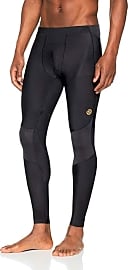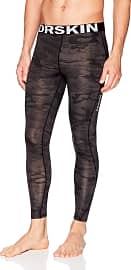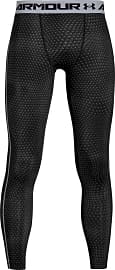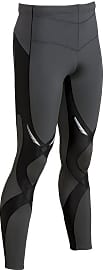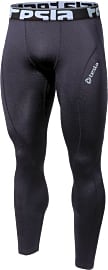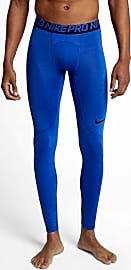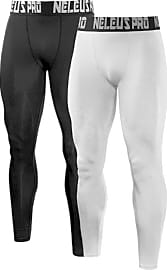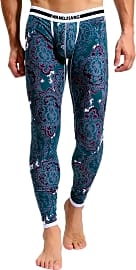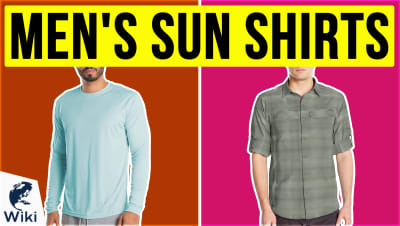The 10 Best Men's Leggings

This wiki has been updated 46 times since it was first published in June of 2015. In the old days, serious athletes wore tights to make their training more efficient. Nowadays, modern compression pants and leggings are worn by many men for muscle support, moisture wicking, odor control, and faster recovery times after workouts. Their stretchy, breathable fabric will keep you comfortable during activities like weight lifting, running, cycling, and playing sports. When users buy our independently chosen editorial recommendations, we may earn commissions to help fund the Wiki.
Editor's Notes
February 14, 2020:
Men’s compression pants and leggings have come a long way, and these days they have a lot to offer to anyone with an active lifestyle. They can be designed for muscle support, moisture wicking, and odor control, and are made to keep you comfortable for any physical activity from running to biking to playing team sports to martial arts to skiing. Our selection features many reliable, budget-friendly models that perform well, and today we added two higher-end choices to round out the list. First off, the 2XU Elite MCS come on board. They’re from a company that originated in Australia in 2005 and transformed over time into a global sportswear outfit that sells its wares in 70 countries. If you read its descriptions of its men’s leggings, you’ll see a lot of fancy initials like “MCS,” which stands for “muscle containment stamping,” which essentially means that compression is targeted to the quadriceps and calves to help provide stability and reduce fatigue. “PWX” stands for “power weight flex,” and it refers to the fabric the manufacturer uses that’s lightweight and flexible, and provides compression. Although their high price can turn some away, those who are able and willing to make the investment notice there is a big difference in the quality of the compression here versus the budget-friendly models.
The Skins A400 are another high-end selection that are thoughtfully designed, as their strategically placed panels support muscles around the abdomen, posterior, and legs. The hems are smooth and bonded for comfort, and they’ve also got a chafe-resistant A-seam. They’re suitable for keeping you comfortable in all types of weather, so they’re a good investment whether you live in an area that’s always cold or warm, or where seasons change.
Whether or not you invest in a deluxe pair, you can’t go wrong by stocking your closet with some budget-friendly models, as well. The DrSkin Compression, Under Armour HeatGear, Tesla Baselayer, and Nike Base Layer Training won’t disappoint; the biggest complaint from users involves any issues with sizing. Before ordering any of these, be sure to read reviews to get an idea of whether they run big or small, and feel free to reach out to the manufacturers if you’re unsure of what size to get.
If you’re also in the market for layers of clothing to keep you warm in the cold, check out our list of best men’s merino wool long underwear and best men’s active base layers.
The Argument For Leggings
Perhaps you associate leggings with women's fashion and are having a hard time jumping on the men's leggings bandwagon.
Perhaps you associate leggings with women's fashion and are having a hard time jumping on the men's leggings bandwagon. But if you can let go of your preconceived notions about this product, you could improve your workout experience tremendously. Studies have found that wearing compression garments can help you run faster and feel less fatigued while you do it. This occurs because compression leggings apply pressure to certain parts of the body that can help accelerate blood flow and deliver more oxygen to your muscles. Quality compression garments help your body more efficiently disperse energy throughout your muscles, making intense moves like lunges and sprints feel less laborious.
The oxygen-boosting effects of leggings do more than improve your performance; they also lengthen it. Better circulation helps your muscles dispel lactic acid and other types of waste that are holding you back. This helps you work out longer. The expulsion of waste and lactic acid can reduce delayed onset soreness, too. If you can change your perception of these clothing items, you could avoid the pain that comes around 24 to 72 hours after extreme exercise, and keeps you from hitting the gym again.
Another interesting effect of compression leggings is that the garments help an athlete's proprioception, which is essentially one's awareness of the relationship between their body and the space around it. This can be incredibly beneficial in competitive sports. Now, let's finally address the reason you may not be wearing compression leggings: you feel embarrassed being so exposed. But the gym is where you have you time — it's time you take to improve yourself. You shouldn't be worried about what others think of you or how you look. So, stop letting insecurities hold you back from a better workout.
The History Of Compression Garments
Compression garments didn't appear overnight. Rather, these performance-boosting clothes are a result of several other inventions that preceded them and had to be used together to make them possible. Let's not forget that compression isn't only vital in the athletic arena, but also the medical one. There is some evidence that the residents of ancient Rome and Egypt created makeshift compression wear, but theirs performed more like bindings because they didn't have things like elastic or sewing machines yet. Nonetheless, they were relying on the same concept as modern day compression wear, which is the management of blood flow.
Let's not forget that compression isn't only vital in the athletic arena, but also the medical one.
Compression garments as we know them today couldn't even begin to develop until the invention of the first electric knitting machine, made in 1589, and the improvements made upon it. But even then, the garment world would have to wait for Charles Goodyear to make vulcanized rubber in the mid 1800s. Still, it wouldn't be until years later that sheets of this rubber were cut into thin slivers. Between the early and mid 1900s, several inventors found ways to extrude rubber fibers, and wrap them in fabrics like cotton, to form elastic threads.
Quick on the heels of the creation of elastic came Spandex (sometimes called Lycra or Elastane), patented in 1958. Spandex rapidly stole the spotlight from natural rubber because it boasted more elasticity, strength, and UV-resistance. It first took off in the lingerie and shapewear markets, but eventually found its way into workout clothing. Today, spandex-based compression wear is a beloved item among professional and amateur athletes around the world.
What To Look For In Leggings
If you get a great pair of leggings, you won't even realize you're wearing any because they're designed to remove clothing-related distractions. Look for leggings that contain moisture-wicking technology, so you aren't sitting in your own pool of sweat halfway through your workout. You may also consider flat seam construction to reduce chafing and create a slim profile if you wear your leggings under other pants. Good contouring around the knees will offer a nice range of motion, too. Make sure compression is especially good around your more private regions because any motion in that area is bound to be detrimental to your workout.
A rating of 50 and up is ideal if you spend between 30 minutes and an hour exercising outdoors.
If you like to take your workouts outdoors in the winter, make sure your leggings are rated for cold weather. You don't want to cut your stair lunges short because of frostbite. You might also want a pair in a bright color, so vehicles can see you if you run outside at night. If your choice of outdoor exercise is a ride on your mountain bike, look for a pair that rises to your calves so they don't snag your pedals. For daytime, outdoor workouts, make sure your leggings have a high UPF rating. A rating of 50 and up is ideal if you spend between 30 minutes and an hour exercising outdoors.
When it comes to comfort, you'll want a wide, soft, and flexible waistband that stays in place without squeezing you too tightly. You don't want the embarrassment of finding, mid-squats, that your leggings have slid down past your...you know. You might even want a drawstring closure if you know your weight will fluctuate as a result of your workouts. If you often forget to pack an extra set of underwear for the gym, you are in luck, as there are leggings that can be worn sans underwear. On the topic of packing for the gym, you might want leggings that fold down into a small size and take up minimal space in your backpack.


